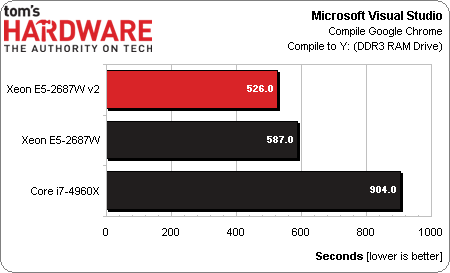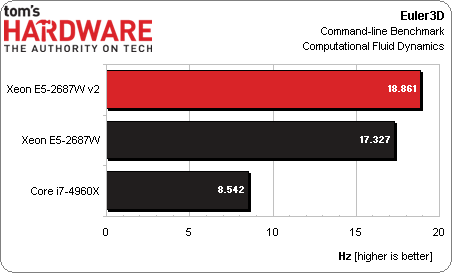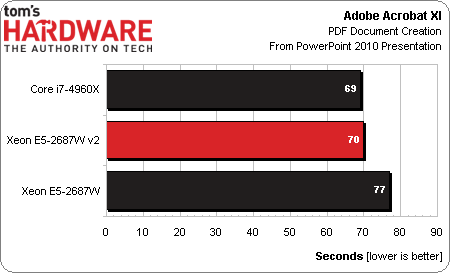Intel Xeon E5-2600 v2: More Cores, Cache, And Better Efficiency
Intel recently launched its Xeon E5-2600 v2 CPU, based on the Ivy Bridge-EP architecture. We got a couple of workstation-specific -2687W v2 processors with eight cores and 25 MB of L3 cache each, and are comparing them to previous-generation -2687Ws.
Results: Productivity
Compiling Google’s Chrome Web browser in Visual Studio 2010 shows off another strength of our dual-CPU machines. Not all development projects are going to benefit as profoundly; however, in this particular test, Intel’s Core i7-4960X needs more than 15 minutes to finish the job. Last generation’s Xeon E5-2687W wraps up in less than 10 minutes. Two Intel Xeon E5-2687W v2s get back to idle in fewer than nine minutes.
Based on the STARS Euler3D computational fluid dynamics production code, Euler3D’s workload is described as follows:
“The benchmark testcase is the AGARD 445.6 aeroelastic test wing. The wing uses a NACA 65A004 airfoil section and has a panel aspect ratio of 1.65, a taper ratio of 0.66, and a 45 degree quarter-chord sweep angle. This AGARD wing was tested at the NASA Langley Research Center in the 16-foot Transonic Dynamics Tunnel and is a standard aeroelastic test case used for validation of unsteady, compressible CFD codes…The benchmark CFD grid contains 1.23 million tetrahedral elements and 223 thousand nodes. The benchmark executable advances the Mach 0.50 AGARD flow solution. Our benchmark score is reported as a CFD cycle frequency in Hertz.”
Because each Xeon E5-2687W v2 sports eight cores, the Ivy Bridge-EP-based setup is easily more than twice as fast as a six-core Core i7-4960X. The current-gen Xeons are also quite a bit quicker than their predecessors thanks to higher clock rates.
Software developer ABBYY puts a lot of effort into optimizing for threading, and the latest version of FineReader continues utilizing all of the host processing resources we throw at it, so long as each core gets 512 MB of RAM. You might not consider optical character recognition to be a compute-intensive operation, but the Xeon E5-2687W v2s finish our benchmark workload in half the time as a flagship Core i7.
In contrast, printing a PowerPoint presentation to PDF is a decidedly single-threaded operation that doesn’t benefit from many cores. But because of Intel’s shift to 22 nm manufacturing and its effect on power, the company can set its Xeon E5-2687W v2 to run at 4 GHz in situations where only one core is active. As a result, the new Xeon is just about as fast as the six-core -4960X also based on the Ivy Bridge architecture, and almost 10% faster than the original Xeon E5-2687W.
Get Tom's Hardware's best news and in-depth reviews, straight to your inbox.
-
GL1zdA1 Does this mean, that the 12-core variant with 2 memory controllers will be a NUMA CPU, with cores having different latencies when accessing memory depending on which MC is near them?Reply -
Draven35 The Maya playblast test, as far as I can tell, is very single-threaded, just like the other 3d application preview tests I (we) use. This means it favors clock speed over memory bandwidth.Reply
The Maya render test seems to be missing O.o
-
Cryio Thank you Tom's for this Intel Server CPU. I sure hope you'll make a review of AMD's upcoming 16 core Steamroller server CPUReply -
voltagetoe If you've got 3ds max, why don't you use something more serious/advanced like Mental Ray ? The default renderer tech represent distant past like year 1995.Reply -
lockhrt999 "Our playblast animation in Maya 2014 confounds us."@canjelini : Apart from rendering, most of tools in Maya are single threaded(most of the functionality has stayed same for this two decades old software). So benchmarking maya playblast is as identical as itunes encode benchmarking.Reply -
daglesj I love Xeon machines. As they are not mainstream you can usually pick up crazy spec Xeon workstations for next to nothing just a few years after they were going for $3000. They make damn good workhorses.Reply -
InvalidError @GL1zdA1: the ring-bus already means every core has different latency accessing any given memory controller.Memory controller latency is not as much of a problem with massively threaded applications on a multi-threaded CPU since there is still plenty of other work that can be done while a few threads are stalled on IO/data. Games and most mainstream applications have 1-2 performance-critical threads and the remainder of their 30-150 other threads are mostly non-critical automatic threading from libraries, application frameworks and various background or housekeeping stuff.Reply -
mapesdhs Small note, one can of course manually add the Quadro FX 1800 to the relevant fileReply
(raytracer_supported_cards.txt) in the appropriate Adobe folder and it will work just
fine for CUDA, though of course it's not a card anyone who wants decent CUDA
performance with Adobe apps should use (one or more GTX 580 3GB or 780Ti is best).
Also, hate to say it but showing results for using the card with OpenCL but not
showing what happens to the relevant test times when the 1800 is used for CUDA
is a bit odd...
Ian.
PS. I see the messed-up forum posting problems are back again (text all squashed
up, have to edit on the UK site to fix the layout). Really, it's been months now, is
anyone working on it?




